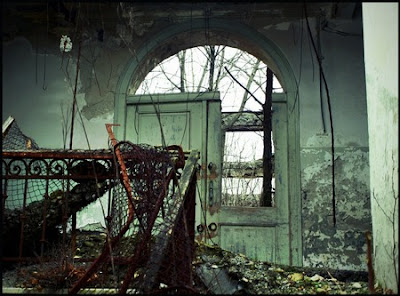As the artist conceptualizes their work, they designate a specific subject or focus for that work. There is a particular message that they wish to convey with their subject and as a result, a given selection of details that must be emphasized in their work.
In a particular work, the artist will need to select the appropriate 'focus' for the piece. This focus will reveal a subject in greater detail while de-emphasizing the surrounding subjects to provide a greater contrast that allows the subject to stand out. This technique of emphasizing a particular subject with a selected focus is commonly described as a depth of field in photography and cinematography. In a visual sense it is the distance between the nearest and farthest objects in frame that appear 'acceptably sharp.'
 |
| Photo Credit |
A deep focus or large depth of field is common in cinematography and is also quite common in fantasy novels as well. In a deep focus shot the foreground, middle-ground and background are all in focus. This emphasizes moderate detail across all planes of the frame and in narrative terms this is revealed as detailed descriptions of the world, characters, atmosphere even political machinations. While there will be given subjects within the frame they will only exhibit an equal level of detail as that of the rest of the frame regardless of positional emphasis(if they're the main characters, subjects, etc.).
Ex: The rusted mechanical horse slowed its piston-timed pace until it brought the carriage to a stop before us. It was clear that the Algenie were being selective about transit updates in this section of the city. "Select your destination sir." The robotic voice echoed.
The counterpoint, a shallow focus or small depth of field is often more effective. In a shallow focus the subject is emphasized while de-emphasizing the foreground and background. This emphasizes great detail on a single plane and significantly less detail on surrounding subjects and in a narrative sense, is common in most contemporary novels. The subjects in frame will exhibit varying levels of detail depending on their positional emphasis.
Ex: The cab swerved across traffic in response to my hail drawing to a stop in front of us. I jumped in and tried not to recoil at the stench. The cabbie looked over his shoulder, "Where to boss?"
A balance between the shallow focus and deep focus is the selective focus, a large depth of field with selected emphasis. This focal method allows for a larger detailed frame than a shallow focus but also provides more detail than a deep focus on selected subjects in the frame. In a narrative sense this is more uncommon but also generates an air of inconsistency.
Ex: The battered yellow cab swerved around the sanitation truck as the workers hopped off. The car dodged a pristine Mercedes and slid to a stop in front of me almost taking my toes off the curb. I shook my head as horns sounded in the distance and I pulled the door handle. The scent of sweat and decay greeted me as I slid in on the cheap vinyl seat. "Where to boss?" The large cabbie asked with a thick Brooklyn accent.
Every creative piece has a selected depth of field, a focal length that establishes what in frame is emphasized and de-emphasized. Once a focal length is selected, it is abundantly apparent to the audience when that focal length changes. If there is a shift within the focus it often weakens the piece and often distinguishes a professional piece from the amateur. Do you know what focal length you're using?








6 comments:
I always learn new things reading your blog, Phil! Thanks. I'm going to think on this one. The shift within focus has thrown me when reading, so I definitely want to make sure I don't do it!
Heh, you know me, I love looking at things across mediums. Even if you just skim the wiki article about depth of field I think you can get a better idea on how it can affect stories and other mediums. Welcome to photography via narrative ;-)
Very interesting. I like the way you applied the term focus to writing. I never thought about it that way.
Thanks Bella. I really prefer to find different perspectives on subjects. Most tips for an artistic medium can be shared across all mediums. Thank you for stopping by.
Hi Philip.
I think that different focal lengths should be applied to scenes individually. Depending on the message one wants to give to the audience, close shots or far shots should be shown in each scene.
Same goes with the blur. There are wide scenes, where everything appears in a blur, except the one subject which conveys the message; or everything is black & white, except the target which is colored, etc.
So, focal length or type depend on the target on which the "focus" is wanted. The target is the messenger.
Interesting article :)
Jacqvern, I was thinking in terms of the whole piece being one composition but it's another valid approach, just like cinematography you adjust each scene to suit the overall story but if you randomly use a fisheye or a different DOF that you've never used before it can show. Isn't it fun thinking of the cross-medium techniques that can be used? Just wait I'm sure an HDR post is coming. ;-)
Post a Comment
What is your insight on this?